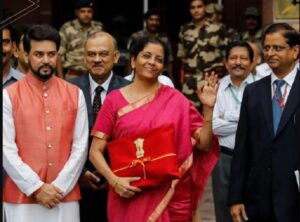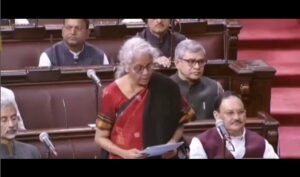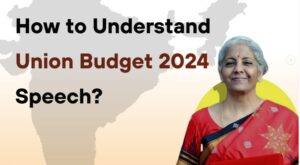Decoding India’s Budget:
Understanding the government’s budget can sometimes feel like deciphering a complex puzzle, but in reality, it’s not so different from managing a household budget. As Finance Minister Nirmala Sitharaman prepares to unveil the central government’s budget on February 1, let’s demystify the process, drawing parallels with our own household finances.
The Household Budget Analogy:
Much like a household budget tracks income and expenses, the government’s budget accounts for the entire country’s financial activities over a 12-month period, from April 1 to March 31. Imagine it as a ledger, detailing where the country earns money and how it plans to spend it.
Origin of the Term “Budget”:
The term “budget” originated in the British Parliament when the Finance Minister carried financial accounts in a leather bag called “Buget” in French. This practice led to the term “budget” in English, universally adopted to describe financial planning for both countries and households.
Interim Budget: Why Different This Time?
With elections looming, the Finance Minister will present an Interim Budget this February instead of the full year’s budget. This budget will cover the next few months until a new government takes over in June-July. Typically, the Interim Budget avoids major policy announcements, but some restrictions exist under the Election Commission’s Code of Conduct to prevent undue influence.

The Income Channels:
The country’s income sources vary, including taxes, revenue, and debt. All these earnings are pooled into a ‘consolidated fund,’ owned by the Parliament. Withdrawal from this fund requires Lok Sabha approval, ensuring indirect public consent.
Role of Parliament:
The Consolidated Fund is directly linked to the Lok Sabha, where MPs are elected by the people. To withdraw funds, the government must seek approval through an Appropriation Bill under Article 114 of the Constitution. The role of Parliament in deciding certain aspects of India’s budget is crucial, ensuring democratic oversight and accountability. Various constitutional provisions and parliamentary procedures outline how the legislative body contributes to the approval and scrutiny of financial matters. Here’s an overview:
Consolidated Fund of India:
The Consolidated Fund of India is the primary account where all government revenues are deposited, and from which expenditures are made. It is owned by the Parliament, emphasizing the authority of the legislative body over financial matters.
Approval through Appropriation Bill (Article 114):
The Appropriation Bill, as per Article 114 of the Constitution, is a key instrument through which the government seeks permission from the Lok Sabha (the lower house of Parliament) to withdraw funds from the Consolidated Fund for specific purposes. Until this bill is enacted, the government cannot access funds from the Consolidated Fund.

Annual Financial Statement (Article 112):
Under Article 112 of the Constitution, the government is mandated to present a full account of its earnings and expenditures in the form of an Annual Financial Statement before the Lok Sabha every year. This statement provides a comprehensive overview of the government’s financial activities during the preceding year and its plans for the upcoming fiscal year.
Approval of Budgetary Allocations:
The detailed budget, presented by the Finance Minister, includes allocations for various ministries and departments. Parliament, especially the Lok Sabha, has the authority to debate and approve these allocations. This process involves Members of Parliament (MPs) discussing and voting on each component of the budget, ensuring that the financial priorities align with the national interest.
Scrutiny by Parliamentary Committees:
Parliamentary committees, such as the Public Accounts Committee (PAC) and the Estimates Committee, play a vital role in scrutinizing budgetary allocations and expenditures. These committees review the utilization of funds, assess the effectiveness of government programs, and provide recommendations for improvement.

Question Hour and Zero Hour:
During parliamentary sessions, Question Hour and Zero Hour provide opportunities for MPs to seek clarification and information regarding budgetary matters. Ministers are required to respond to questions, offering transparency and accountability in financial decision-making.
No Taxation Without Representation:
The principle of “No Taxation Without Representation” is integral to parliamentary democracy. As taxes directly impact citizens, any changes in tax policies or rates are subject to parliamentary approval. The Finance Bill, presented alongside the budget, outlines tax proposals that require parliamentary endorsement.
Public Debate and Discussion:
The budget is subjected to extensive debate and discussion in both houses of Parliament. This process allows MPs to express the concerns and views of their constituents, ensuring that diverse perspectives are considered before finalizing the budget.
Rajya Sabha’s Role:
While the Lok Sabha has the primary authority over money matters, the Rajya Sabha (the upper house of Parliament) can discuss the budget but does not have the power to reject or amend it. This ensures that the budget-making process is largely accountable to the directly elected representatives of the people.
In essence, Parliament’s role in deciding certain aspects of India’s budget is rooted in constitutional principles and democratic norms. It acts as a check-and-balance mechanism, ensuring that financial decisions align with the overall welfare and interests of the citizens.

Budget Preparation Process:
The budget preparation process is a meticulous and multifaceted endeavor that involves data-driven decision-making, continuous collaboration, and adherence to traditions that highlight the significance of confidentiality and teamwork in shaping the financial roadmap of the nation. The intricate process of budget preparation begins about six months in advance, involving multiple stages:
Data Collection:
In September, circulars are issued to ministries and departments to provide data on funds required for the upcoming year.
Daily Meetings:
Finance Minister and key officials meet daily during the budget-making process.
Allocation Decisions:
By October-November, the Finance Ministry decides how much funding each ministry or department will receive.
Continuous Inputs:
Inputs from the Prime Minister, Finance Minister, and NITI Aayog are continuously incorporated, involving a team of experts from various fields.
Consultations:
The Finance Minister engages with industry, organizations, and experts for insights before finalizing the budget.
Blueprint and Printing:
After finalizing all aspects, a blueprint is prepared, and the budget document is printed.

Secrecy and Tradition:
The budget-making process is shrouded in secrecy to avoid leaks. Selected officers of the Ministry of Finance work on the budget document using de-linked computers to prevent information leakage. During the final stages, officers and employees stay within the offices of North Block for two to three weeks, ensuring confidentiality.
Conclusion:
As Finance Minister Nirmala Sitharaman prepares to present the Interim Budget, it’s essential to recognize the parallels between managing a household budget and the intricate financial planning at the national level. The budget is not merely a set of numbers; it’s a reflection of the country’s economic health and future aspirations. Stay tuned as we unravel the intricacies of India’s financial roadmap on February 1.
For more related news – Political News
Pics Courtesy: Instagram
